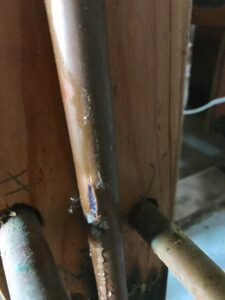Let’s face it, temperatures very rarely get below freezing in our parts. Still, though, it has been known to happen. In fact, weather can surprise even the most prepared. Look at all the homeowners in the Texas area last winter who were surprised by some seriously hazardous winter weather! Without the infrastructure to support it, many of them suffered power loss and more.
We are fans of “being ready for anything,” and while frozen pipes are not a top concern with our mild winters, it’s still something you can be aware of and know how to manage just in case we have some nights that dip below freezing. Hey, it’s been known to happen!
Read on to learn more.
Preventing Frozen Pipes
It may seem like overkill in a climate such as ours, but this really is a case of “it’s better to be safe than sorry.” Think of it this way–if there is any place where it’s easiest to prevent frozen pipes, it’s a climate like ours!
The first thing you should do is open and drain your outdoor faucets when the forecast calls for below-freezing weather, at least at night. The pipes connected to these faucets will be the most susceptible to freezing.
Ensure that the water flow for any points that you turn on a faucet for sprinklers or hose is also shut off. You might even want to get insulated caps for your hose and faucet openings–although this probably won’t be necessary since it’s even rarer for temperatures to stay cold long enough for this to be necessary. Here are some other prevention tips:
Insulate Your Pipes
This is one preventative tip that you can do one year and never have to think about again. There are some pipes in your home that may be more sensitive than others to freezing temperatures, but you still have to use them during the winter. For example, if you have a sink in your garage, or if any of the walls with plumbing in it are outdoor-facing, then they can freeze up.
Fortunately, you can buy really affordable pipe insulating sleeves to keep the temperature of the water in your pipes from dropping as low as the temperature outside. Of course, you can’t dig into your drywall to make this happen, so where do you apply this simulation? Any pipes that are under sinks is a good place to start. Then, while we know this is rare in our area, if your home has a basement, go put insulation sleeves on any exposed plumbing pipes down there.
Disconnect Your Hoses
You probably have hoses you use outdoors during the warmer days of the year, right? Before temperatures have a chance to drop too much, you should disconnect and drain these hoses, and store them inside.
The problem with frozen pipes isn’t that they won’t thaw out–but rather when they do thaw out, they create a negative pressure which leads to the plumbing bursting. This means you have to pay for repairs.
Reach out to DeHart Plumbing, Heating, and Air Inc. today to get in touch with a qualified plumber in Modesto, CA.


